
Rambutan is a medium-sized tropical tree in the family Sapindaceae. The name also refers to the edible fruit produced by this tree. The rambutan is native to Southeast Asia. It is closely related to several other edible tropical fruits, including the lychee, longan, pulasan, and quenepa.
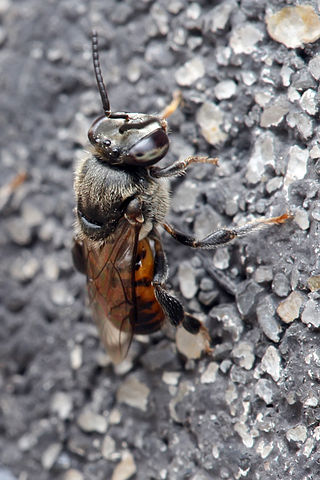
Stingless bees (SB), sometimes called stingless honey bees or simply meliponines, are a large group of bees (from about 462 to 552 described species), comprising the tribe Meliponini (or subtribe Meliponina according to other authors). They belong in the family Apidae (subfamily Apinae), and are closely related to common honey bees (HB, tribe Apini), orchid bees (tribe Euglossini), and bumblebees (tribe Bombini). These four bee tribes belong to the corbiculate bees monophyletic group. Meliponines have stingers, but they are highly reduced and cannot be used for defense, though these bees exhibit other defensive behaviors and mechanisms. Meliponines are not the only type of bee incapable of stinging: all male bees and many female bees of several other families, such as Andrenidae and Megachilidae (tribe Dioxyini), also cannot sting.

Caryocar is a genus of flowering plants, in the South American family Caryocaraceae described as a genus by Linnaeus in 1771. It is native primarily to South America with a few species extending into Central America and the West Indies.

Dekeyser's nectar bat is a bat species found in Brazil and Bolivia.
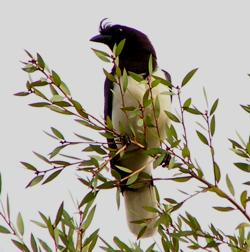
The curl-crested jay is a species of jay native to South America.

Caryocar nuciferum, the butter-nut of Guiana, is also known as pekea-nut, or – like all other species of Caryocar with edible nuts – "souari-nut" or "sawarri-nut". It is a fruit tree native to northern Brazil, Colombia, Costa Rica, Guyana, Panama, and Venezuela.

Alchornea glandulosa is a tree species of the Acalyphoideae native to South America, growing in southern Brazil from Minas Gerais to Rio Grande do Sul. It is locally known as tamanqueiro, tapiá or amor seco. This gnarled tree grows preferentially in riparian forest, where it a common pioneer species growing to a height of 10–20 m. It is essentially evergreen, though in the hot austral summer months there is a more pronounced changeover of leaves, and branches are denuded to some extent.
Apiomerus pilipes, the bee assassin, is an insect that feeds on bees. It is found in South America and reported from Venezuela, Colombia, French Guiana, and Brazil. Like other members of the genus, females of this species have well-developed hind abdominal foliaceous appendages which can be coated with plant-derived resin.
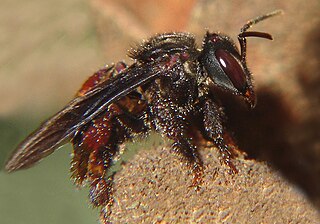
Trigona spinipes is a species of stingless bee. It occurs in Brazil, where it is called arapuá, aripuá, irapuá, japurá or abelha-cachorro ("dog-bee"). The species name means "spiny feet" in Latin. Trigona spinipes builds its nest on trees, out of mud, resin, wax, and assorted debris, including dung. Therefore, its honey is not fit for consumption, even though it is reputed to be of good quality by itself, and is used in folk medicine. Colonies may have from 5,000 to over 100,000 workers.

Melipona bicolorLepeletier, 1836, commonly known as Guaraipo or Guarupu, is a eusocial bee found primarily in South America. It is an inhabitant of the Araucaria Forest and the Atlantic Rainforest, and is most commonly found from South to East Brazil, Bolivia, Argentina, and Paraguay. It prefers to nest close to the soil, in hollowed trunks or roots of trees. M. bicolor is a member of the tribe Meliponini, and is therefore a stingless bee. This species is unique among the stingless bees species because it is polygynous, which is rare for eusocial bees.

Melipona beecheii is a species of eusocial stingless bee. It is native to Central America from the Yucatán Peninsula in the north to Costa Rica in the south. M. beecheii was cultivated in the Yucatán Peninsula starting in the pre-Columbian era by the ancient Maya civilization. The Mayan name for M. beecheii is xunan kab, which translates roughly to "regal lady bee". M. beecheii serves as the subject of various Mayan religious ceremonies.

Melipona subnitida is a neotropical bee species in the Apidae family found in the dry areas of Northeastern Brazil. This species of stingless bees practices single mating, monogynous habits.
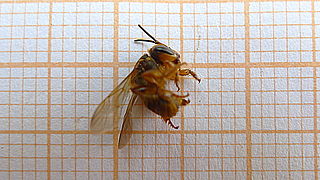
Scaptotrigona postica is a species of stingless bee that lives mainly in Brazil. It is a eusocial bee in the tribe Meliponini. S. postica is one of 25 species in the genus Scaptotrigona and is a critical pollinator of the tropical rain forests of Brazil. They construct their nests in hollowed sections of tree trunks, allowing for effective guarding at the nest entrance. This species shows colony structure similar to most members of the Meliponini tribe with three roles within the colony: queen, worker, and male. S. postica individuals have different forms of communication from cuticular hydrocarbons to pheromones and scent trails. Communication is especially useful during worker foraging for nectar and pollen through the Brazilian tropical rain forests. S. postica is a very important pollinator of the Brazilian tropical rain forests and is widely appreciated for its honey. Stingless bees account for approximately 30% of all pollination of the Brazilian Caatinga and Pantanal ecosystems and up to 90% of the pollination for many species of the Brazilian Atlantic Forest and the Amazon.

Paratrigona subnuda, commonly known as the jataí-da-terra, is a species of eusocial stingless bee in the family Apidae and tribe Meliponini. These social bees are prevalent in Neotropical moist forests, including Brazilian Atlantic and other South American forests. They inhabit spherical nests in moist underground environments with their forest habitats. Within their Neotropical habitats the P. subnuda is considered to be a very successful and common species of bee. P. subnuda’s main source of food is pollen and nectar from a large variety of native Mesoamerican tropical plants. They have been extensively studied due to social conflicts arising from single mate behaviors and particular virgin behaviors. P. subnuda also exhibits the particular daily behavior in which they open the nest entrance at dawn and close the entrance at dusk when all their activities are done.

Melipona quadrifasciata is a species of eusocial, stingless bee of the order Hymenoptera. It is native to the southeastern coastal states of Brazil, where it is more commonly known as mandaçaia, which means "beautiful guard," as there is always a bee at the narrow entrance of the nest. M. quadrifasciata constructs mud hives in the hollows of trees to create thin passages that only allow one bee to pass at a time. Because they are stingless bees, M. quadrifasciata is often used as pollinators in greenhouses, outperforming honey bees in efficiency and leading to overall larger yields of fruits that were heavier, larger, and contained more seeds.
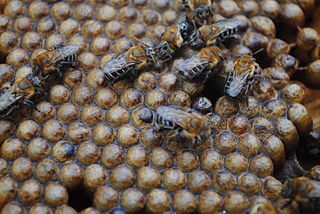
Melipona scutellaris is a eusocial stingless bee species of the order Hymenoptera and the genus Melipona. It is considered to be the reared Melipona species with the largest distribution in the North and Northeast regions of Brazil, with records from Rio Grande do Norte down to Bahia. Its common name, Uruçu, comes from the Tupi "eiru su", which in this indigenous language means "big bee". Their honey is highly desirable and the materials they create for nests have been proven to be a promising source of antibiofilm agents and to present selectivity against human cancer cell lines at low concentrations compared to normal cells.

Trigona fuscipennis is a stingless bee species that originates in Mexico but is also found in Central and South America. They are an advanced eusocial group of bees and play a key role as pollinators in wet rainforests. The species has many common names, including mapaitero, sanharó, abelha-brava, xnuk, k'uris-kab, enreda, corta-cabelo, currunchos, zagaño, and enredapelos.

Melipona capixaba, commonly known as uruçu negra in Brazil, is a species of eusocial stingless bees of the order Hymenoptera. It is endemic to the mountainous region of the State of Espírito Santo, Brazil. Since 2003, it has been included on the list of threatened species produced by the Brazilian Ministry of the Environment, and is the only eusocial insect on this list.

Hymenaea stiginocarpa is an irregularly shaped, mostly 6–9 m (20–30 ft) high tree that has been assigned to the pea family. It has a twisted spindle-shaped trunk, a very rough grey bark, and reddish-brown twigs. The deciduous leaves consist of two large asymmetrical leaflets with an entire margin. The flowers occur in clusters of up to thirty at the end of the branches. It produces edible, highly appreciated fruits, which are often collected from the wild and used by local people. The vernacular name of this species in Brazil is jatobá do cerrado.

Campomanesia adamantium, commonly known as gabiroba, guavira, or guabiroba do campo, is a short shrub-like plant that grows no taller than 1.5 meters on average It is natively found in the central part of South America, in Paraguay and Brazil. The plant produces small yellow-green edible fruits



















